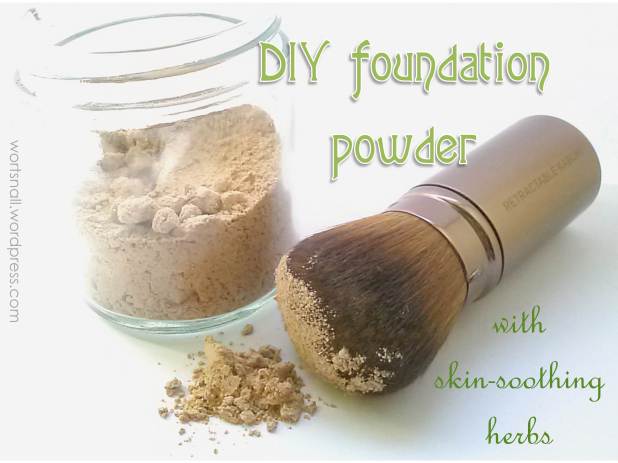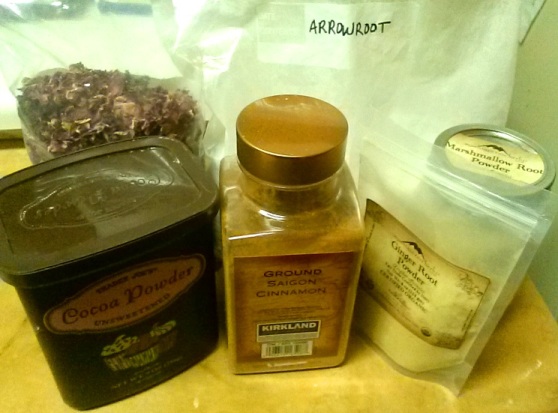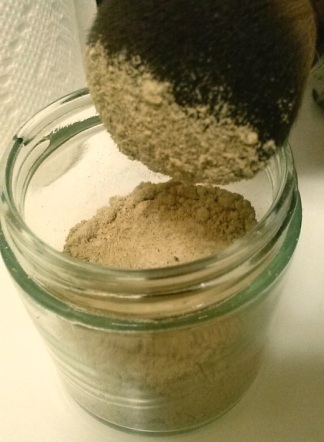Over the past several years I’ve been gradually getting rid of scary chemical things that go in, on, or around my body. I’m satisifed with where I’m at in terms of cleaning products, both household and body, rather less satisfied with my diet. But make-up was something that just seemed a bit beyond my capabilities, schedule, or budget. Too much like chemistry, basically. I was worried about the safety of the mineral ingredients, and also that I would invest money in pigments that I had no other use for only to have my attempted blends fail miserably. On the other hand, I am truly terrified of some of the ingredients in store-bought make-up. So I had basically stopped wearing make-up at all, unless there was some dressy occasion. All the dressy items in my wardrobe are in storage because when I moved halfway across the country to take care of my mom, I honestly didn’t think she would live long enough for me to need a change of style. I threw out or gave away about 1/3 of my belongings, packed a suitcase and a couple of boxes, and the rest went into storage. In Minnesota. Now I can’t afford to move my stuff out here and I don’t have room for it anyway. So, long story short, my style is now tres casual, and all I can say to that is thank goodness I live in California where you can wear shorts and Berkies to your prom if you want. Anyway, if I have to go someplace a little more dressy I try to compensate for my clothes with make-up. But otherwise, I’m pretty lazy about it these days. Still, I do enjoy the creativity of it and the different looks and effects that are possible. If I could feel good about what I’m putting on my face I would definitely be interested.
And now thanks to the magic of the internets I discovered some recipes for powder, blush, and eyeshadow that utilize kitchen ingredients that I already have anyway. Things I can actually eat (in fact, that’s why I have them in the first place). And that gave me all kinds of ideas. Here are some examples:
These recipes all use arrowroot as a base, with added powders (clays, spices, etc.) that contribute the color, and a few drops of oil to help the powder adhere.
My first thought was that we could improve these recipes by adding some more herbal goodness. The ingredients in my own version of foundation powder are listed below. I have included the quantities, which will vary for you because all skin tones are different, but just to give you an idea of the quantities involved. For reference, I am a very white person but have a definite red undertone to both my skin and hair. I turn very pink at the slightest provocation. Also, I live in a very dry climate which probably affects the performance of the powder in unknown ways. I will explain the reason for each ingredient, possible variations, and the process I used.
Ingredients
- Arrowroot powder (2 Tbsp + 1/4 tsp)
- Cocoa powder (1 tsp)
- Cinnamon (1 1/4 tsp)
- Powdered ginger (1/4 tsp)
- Powdered marshmallow root (1 tsp)
- Red rose petals (about 4 tsp)
- Vitamin E oil (7 drops)
- Essential oil (2 drops)
Arrowroot powder. Arrowroot, like iocaine powder, is odorless, colorless, and tasteless (but not poisonous). It is bright white and very similar to cornstarch but not GMO and it doesn’t seem to cause the skin irritation that is sometimes reported with cornstarch. However, you could experiment with cornstarch or tapioca flour. Whatever you use, it will be the main ingredient in your powder and it needs to be very finely powdered. It doesn’t need to be refrigerated, but bear in mind that ultimately it is perishable. (That said, I’ve had cornstarch in my cupboard for years and it’s still fine.) Arrowroot absorbs oil and thus reduces shine. I have some ground eggshells which can be used as translucent face powder, and considered adding those, but as it happened I ended up with too much white and didn’t want to make a giant batch by adding more of everything else. Still, it’s worth considering.
Cocoa powder. Cocoa adds a warm medium brown. It’s a good basic color for everyone no matter what your skin tone (since human skin comes in shades of brownish) but use very little if you’re very light skinned. For a darker brown you could use allspice.
Cinnamon. Cinnamon is a more orangey-brown. Cinnamon is what’s known as a rubefacient, meaning it brings blood, and thus oxygen, to the surface. In large quanities this creates a warming and reddening effect and can irritate the skin, but you won’t be using very large amounts for this. If you have any reactions to it, you could substitute nutmeg which is very similar in color.
Powdered ginger. Ginger is another rubefacient. It is anti-inflammatory and thus helps soothe the skin.
Powdered marshmallow root. This is my own addition. I am referring of course to the herb marshmallow (Althaea officinalis), not the kind made of sugar. Marshmallow root is mucilaginous and very skin-soothing. It is a creamy white color. Marshmallow is generally used in moistened form, and I couldn’t find information about the possible benefits of using it dry. But I can’t see why there wouldn’t be any. First of all, the powder will be in contact with the moisture of your skin and the ambient air, and second, it will be on your face for (hopefully) hours, giving it lots of opportunity to be therapeutic.
Red rose petals. I used dried red rose petals to add pink to my powder (I need a lot of pink because I am a very pink person). Roses are astringent and skin-soothing. Again, I don’t know the specifics of using dried rose petals topically but I can only assume it is at least somewhat beneficial. You could alternatively use dehydrated beet root powder, which is a brighter red, or hibiscus, which is more of a purplish red. Alkanet is another possibility–it is a burgundy color.
Vitamin E oil. Aside from being beneficial to the skin, the oil helps bind the powder together and to your skin. The powder will still be dry and, well, powdery, but any improvement in sticking powder is good.
Essential oil. This is completely optional, but again the oil adds some sticking power. Plus you get whatever skin benefits are in the oil you use. I used patchouli because I thought it would blend well with the scents of the spices and cocoa (it did) and it smells good on me, not like dirty hippy at all.
Process
For this procedure you will ideally need a coffee or spice grinder. Maybe you could do this with a mortar and pestle, I didn’t try. The point is that you need all the powders to be very fine in order to stick to your skin, and you want them thoroughly blended together. It also helps to get the oils well blended.
I started with 1 Tbsp arrowroot, 1 tsp marshmallow, 1 tsp cinnamon, and 1 tsp cocoa powder. This came out way too brown for me.
I then added 1/4 tsp ginger and 3 1/4 tsp more arrowroot (I started out adding it by 1/4 teaspoonfuls, then went to 1/2 teaspoonfuls). Then it was too light, but still too brown and not my-flesh-colored enough.
So I added about 2 tsp rose petals. I didn’t actually measure them out, I confess. They were not powdered so I put them in the spice grinder with all of the powder-so-far and gave it a whirl. I tried it on the back of my hand and on my cheek–still too light.
So then I added 1/4 tsp cinnamon, but that made it too brown again.
I added another approximate 2 tsp rose petals. I tested again on my hand and cheek and this time it looked good.
Once I had the color right, I added the Vitamin E and essential oil. I tried it on my whole face with a powder brush and it stuck perfectly and gave a nice sheer coverage. Huzzah! In total, this added up to about 2 oz of powder by volume.
As I said above, the precise amounts will vary for each person but I recommend starting small because if it all goes pear-shaped you don’t want to have wasted a lot of ingredients. You can always add more but you can’t take any away. Make sure to record exactly how much you used of each ingredient in case you want to replicate it in the future.
Other types of powder-based make-up
Blush, bronzer, and eyeshadow can all be made pretty much the same way, except that for eyeshadow you will probably want to add mica powder for shimmer. Blush will be based on pink-red ingredients and bronzer on brown ones (some further ideas here). If you find you like blending your own make-up you can invest in mineral pigments like ultramarine or iron oxides, but if you have a collection of herbs in your cupboard you might be surprised how many colors you already have. Have fun experimenting!
Some sources for materials:
These are places I get some of my materials and they are just here as suggestions in case you don’t know where to start. I don’t receive any promotional consideration. In fact, while I’m at it, I have no idea what ads WordPress inserts at the end of my posts, so I don’t endorse them.
Herbs, spices, arrowroot: Mountain Rose Herbs, Vitacost, Frontier, Starwest Botanicals
Clays, containers: New Directions Aromatics
Mineral pigments, mica, containers: Saffire Blue



What an interesting post. I love DIY creations. I have never thought about making my own powder foundation before. Sound great!! I have some DIY creations on my blog too, If you are free, would be great if you could check out my blog on http://www.beautypuzzled.wordpress.com x
Thank you for reading! DIYing is the best, you get such a sense of accomplishment plus something useful. I will definitely check out your DIY creations!
Wonderful post….brilliant blend….can’t wait to give it a try!
Thank you! I hope you like it!